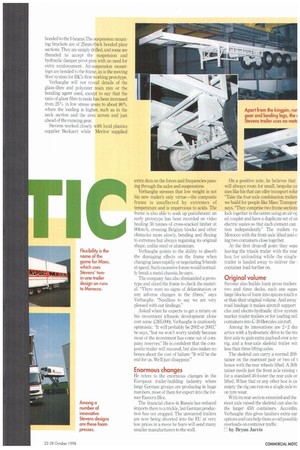H auliers looking for more payload might consider following the lead
Page 52

Page 53

If you've noticed an error in this article please click here to report it so we can fix it.
of IBC: the international haulier is evaluating a bulker trailer built by Belgian specialist Stevens...out of plastic. Conservative hauliers can rest assured that this is no hare-brained idea. Stevens has already used the high-tech composite materials in its well-established bodywork range; now it is starting series production of a fully composite trailer chassis at its new £1.6m factory beside the E17 at Lokoren.
The first trailer off the line with matching composite box-van bodywork and Cargo Floor moving deck system is joining IBC's fleet in Hull where it will work alongside similar steel trailers. These normally tare out at about 75 tonnes; the composite model weighs in at just below 6.0 tonnes, Stevens hopes IBC will take at least 40 more composite trailers and it reports interest from a number of other European operators.
Stevens co-owner and general manager J lierhaeghe reckons a steel trailer chassis made to accept a moving-floor system would weigh about 4,850kg. Stevens' chassis, which carries a worldwide patent, tips the scales at 3,250kg.
Apart from its kingpin, running gear and landing legs, the trailer frame is entirely composite. It comprises an I-beam structure 300mm across the top and bottom rails, both of which are three-piece bonded fabrications. The web section is also 300mm high.
There are seven 125mm-diameter tubular cross-members, all of spun GRP and bolted and bonded to the I-bearns.The suspension mounting brackets are of 25mm-thick bonded plate sections. They are simply drilled, and some are threaded to accept the suspension and hydraulic damper pivot pins with no need for extra reinforcement. Air-suspension mountings are bonded to the frame, as is the moving floor system for IBC's first working prototype.
Verhaeghe will not reveal details of the glass-fibre and polyester resin mix or the bonding agent used, except to say that the ratio of glass fibre to resin has been increased from 25% in low stress areas to about 80% where the loading is higher, such as in the neck section and the area across and just ahead of the running gear.
Stevens worked closely with local plastics supplier Beckaert while Mentor supplied extra data on the forces and frequencies passing through the axles and suspensions.
Verhaeghe stresses that low weight is not his new trailer's only virtue—the composite frame is unaffected by extremes of temperature and is impervious to acids. The frame is also able to soak up punishment: an early prototype has been recorded on video hauling 36 tonnes of cross-stacked timber at 90km/h. crossing Belgian blocks and other obstacles more slowly, bending and flexing to extremes but always regaining its original shape. unlike steel or aluminium.
Verhaeghe points to the ability to absorb the damaging effects on the frame when changing lanes rapidly or negotiating S-bends at speed. Such excessive forces would normally break a metal chassis, he says.
The company has also dismantled a prototype and sliced the frame to check the material. "There were no signs of delamination or any adverse changes in the fibres," says Verhaeghe. "Needless to say we are very pleased with our findings."
Asked when he expects to get a return on his investment (chassis development alone cost sime £265,000), Verhaeghe is cautiously optimistic. "It will probably be 2002 or 2003," he says, "but we won't worry unduly because most of the investment has come out of company reserves." He is confident that the composite trailer will succeed, but also makes no bones about the cost of failure: "It will be the end for us. We'll just disappear."
Enormous changes
He refers to the enormous changes in the European trailer-building industry where large German groups are producing in huge numbers, most of them for export into the former Eastern Bloc.
The financial chaos in Russia has reduced imports there to a trickle, but German production has not stopped. The unwanted trailers are now being diverted into the EU at very low prices in a move he fears will send many smaller manufacturers to the wall.
On a positive note, he believes that will always room for small, bespoke co; nies like his that can offer transport solui "Take the four-axle combination trailers we build for people like Macs Transpor says. 'They comprise two frame section: lock together in the centre using an air-oc ed coupler and have a duplicate set of au electric suzies so that each element can. tion independently" The trailers ru Morocco with the front axle lifted and c ing two containers close together.
At the first drop-off point they sepa leaving the triaxle trailer with the rear box for unloading while the singletrailer is hauled away to deliver the container load further on.
Original volume
Stevens also builds foam press trailers two and three decks, each one squet large blocks of foam into spaces much s: er than their original volume. And away road haulage it makes aircraft support cles and electro-hydraulic drive system market-trader trailers or for loading mil containers into C-30 Hercules aircraft.
Among its innovations are 2+2 dui artics with a hydrostatic drive to the Ira first axle to gain extra payload over a no rig, and a four-axle skeletal trailer wit less than three lifting axles.
The skeletal can carry a normal 2aft tamer on the rearmost pair or two of t boxes with the rear wheels lifted. A 30ft tamer needs just the front axle raising N for a standard 40-footer the rear axle or lifted. When that or any other box is ca empty the rig can run on a single axle to on tyre wear.
With its rear section extended and the most axle raised the skeletal can also ha the larger 45ft containers. Accordin: Verhaeghe this gives hauliers extra ear options and can help them avoid possible overloads on container traffic.
I— by Bryan Jarvis
















































































































